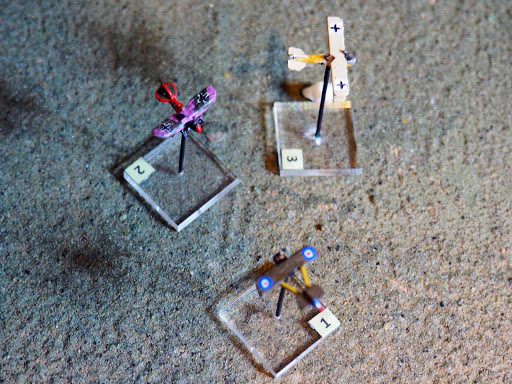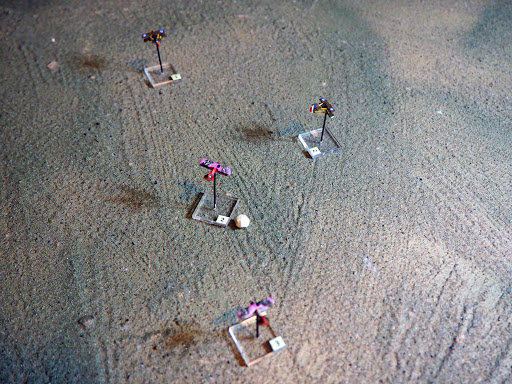A couple of months ago I posted some reports of games of Galleys & Galleons where I used a system of random threat generation to determine opponents for a single ship. It was based on a system shared by Elenderil in THIS post.
The blog post described how he'd adapted it for WW1 air-combat (the original magazine article used it for land warfare), so tonight I thought I'd revisit it and use it in the way it was intended by trying it out in the skies over the Western Front.
It's May 1916 and a couple of DH2s are out on patrol.
The blog post described how he'd adapted it for WW1 air-combat (the original magazine article used it for land warfare), so tonight I thought I'd revisit it and use it in the way it was intended by trying it out in the skies over the Western Front.
It's May 1916 and a couple of DH2s are out on patrol.
They quickly spot an Aviatik two-seater and an escorting Halberstadt single-seater.

(I actually used a different direction indicator to that in Elenderil's post; I couldn't handle the slightly uneven number distribution of his. This one still weights encounters to appearing in front of the aircraft, but the number spread is even on both sides. Also it ties in better with my 45 degree arc game system in 'Spandau and Lewis'. Oh, and I had encounters appear 3D6" away, because it was a better fit for my board.)
The Germans were unaware of the British aircraft, but were turning towards them. One DH2 dived into the attack, but shot wide of the Aviatik. Unfortunately this also alerted the German planes to the presence of the British.
A second Aviatik appeared. as the first broke away and made a run for safety, the two DH2s stalked it, aware that the Halberstadt was turning towards them.
But the British were canny. As the Halberstadt closed in on them, one of the pilots threw his plane around in a tight turn, and raked it with fire, inflicting some damage.
But there were more Germans in the skies. A third Aviatik and second Halberstadt entered the fray. The Aviatik ran for safety, whilst the German scout and a DH2 exchanged fire in a head-on pass.
The two-seaters were now breaking away from the fight, whilst the DH2s were prevented from pursuing them by the attacks of their escorts.
The Germans pressed their attacks very closely indeed.
One of the DH2s had swung out of the action, but returned with a vengeance, getting in behind a Halberstadt.
A burst of fire saw the German plane's wings detach and it plummeted to the trenches below.
The remaining Halberstadt was now in trouble, hemmed in by both British aircraft.
But Lady Luck was not with the British. A third Halberstadt dropped into the fight, rescuing the other plane, and leaving the British planes, which were both damaged, with no sensible option but to make a run for home.
The Germans pursued ruthlessly. A DH2 exploded into a ball of fire.
The other was pressed hard, all the way to the British baseline, but escaped, despite the Germans getting in two final bursts of fire and it dived to safety.
So the encounter was something of a draw, with both sides losing one plane each. The British were very unlucky with their encounters. The system can generate between one and four of them, each of one or two planes, and they got all four of them. In addition the German scout options were either Halberstadt DIIs or Fokker EIIIs, the second being an inferior plane to the DH2. But all three scout encounters came out as the DIIs, which are a better-performing aircraft.
The system worked really well. I created 'rules of engagement' for the threats as they appeared, based on those in the original article. Germans that had not spotted a British plane would fly towards the furthest board-edge until they did, turning as necessary to get there. Single scouts would patrol; they would fly around until they were pointing towards the centre of the board, fly to the centre, and then circle there. If I was uncertain what to do, I rolled dice. Once they'd spotted the British the two-seaters would do all they could to get to their target edge and leave the board, whilst the scouts would engage the DH2s to the best of their ability. Scouts could flee of their home edge if the going got tough.
Anyway, I may try it the other way around sometime, and see what a single EIII can get up to.
The system worked really well. I created 'rules of engagement' for the threats as they appeared, based on those in the original article. Germans that had not spotted a British plane would fly towards the furthest board-edge until they did, turning as necessary to get there. Single scouts would patrol; they would fly around until they were pointing towards the centre of the board, fly to the centre, and then circle there. If I was uncertain what to do, I rolled dice. Once they'd spotted the British the two-seaters would do all they could to get to their target edge and leave the board, whilst the scouts would engage the DH2s to the best of their ability. Scouts could flee of their home edge if the going got tough.
Anyway, I may try it the other way around sometime, and see what a single EIII can get up to.
















Hello
ReplyDeleteI keep meaning to post as I really enjoy your blog. Have you ever seen Jim Hind's "Aces High" and "The Blue Max" rules from the early 1980's? They kept me sane during A-Levels, about the best £2.40 I have ever spent. I liked the combination of realism and playability, including the solo rules. The campaign game was very sobering when life expectancy was so limited. I experimented with rules for psychological pressure too.
I thoroughly recommend the BBC Wings series. If you keep going I think you will be very surprised. Some story lines were pushing probability but others were deeply honest and moving, covering the reality of war not Hollywood romance. The propeller and balloon incidents are stark; it takes an unusual production team to show their heroes as realistic and ruthless rather than simply heroic.
Best wishes
John
Glad you enjoyed the post!
DeleteI do have a copy of 'Aces High' with the 'Blue Max' supplement as well, and played a fair bit of it back in the 1980s. I loved the designer's focus on actions being about missions rather than just dogfights for the sake of it, and try to design my scenarios accordingly. We played the campaign as well. The plane stats in 'Spandau and Lewis' are actually derived from those in 'Aces High'; I dumped a load of information into a spreadsheet from the little data cards, and sorted and filtered it to get a feel for the range of numbers I needed for my game.
I did enjoy Wings, despite its rather pedestrian mid-1970s feel, and will watch some more at some stage. I still have The Water Margin to finish at some stage though :-D
Glad you liked the threat generator. I can’t claim to have done any more than adapt the original idea and it’s to the original designers credit that it can so easily be adapted to other games and fields of combat.
ReplyDeleteThis looks like a really neat little system and great for solo play...looking forward to more game reports!
ReplyDelete